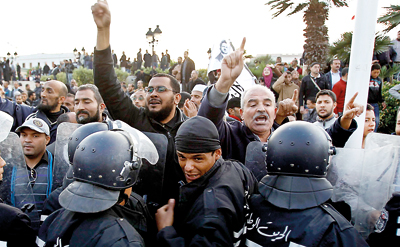Sunday Times 2
The Arab Spring’s crowd psychology
ABU DHABI – In 1896, the social psychologist Gustave Le Bon warned his contemporaries of the dangers of crowds, writing that, “It is necessary to arrive at a solution to the problems offered by [crowds'] psychology, or to resign ourselves to being devoured by them.” As spontaneous protest overtakes organised political movements across the Arab world, the leaders of Tunisia, Egypt, and Libya’s nascent democracies should heed Le Bon’s warning.
Since crowds took to the streets of Tunis, Cairo, Benghazi, and other Arab cities, toppling decades-old regimes, spectators and analysts have wondered where the Arab world is headed. But they have focused almost exclusively on the events’ political dimension: Who are the leaders, and what are their demands?
In fact, the persistence, intensity, and frequency of protests – exemplified in September, when local militia in Benghazi killed US Ambassador to Libya J. Christopher Stevens – demonstrate the role that the culture and psychology of crowds are playing in determining the Arab world’s trajectory. After decades of authoritarian rule, citizens, frustrated with discredited institutions and paralysed political parties, have begun to employ social media to organise civil resistance.
As a result, countries affected by the Arab Spring now face political spheres that are shaped by crowd dynamics, rather than by genuine political or ideological movements. Indeed, much of what is happening in the Arab world today can be best understood through the study of crowds.
Crowds are the opposite of organisations; rather than being dominated by rigid hierarchies, they are often led by individuals with no formal rank. And, unlike political movements, crowds tend to form quickly and organically, like dark clouds gathering to form a storm, and their objectives are immediate: surround this police station, seize that ministry, etc. In “crowd politics,” emotions often supersede goals.
Lebanon was perhaps the first Arab country to experience crowd politics. After Prime Minister Rafic Hariri was assassinated in February 2005, crowds led by various political parties filled Martyrs’ Square in downtown Beirut.

Pro-government Islamists clash near riot police during a demonstration against labour union UGTT that called for a general strike and downfall of the government led by the Islamist Ennahda party at Kasba in Tunis on December 4. Reuters
But non-organised crowds eventually eclipsed structured groups, becoming a dominant force in Lebanese politics. In fact, Lebanon’s two competing political coalitions, the March 8 alliance and the March 14 alliance, take their names from major crowd gatherings that occurred on those dates in 2005.
Lebanon’s experience reveals the discord between the psychology of crowds and the goals of the political elites who rally behind them – a conflict that can also be seen in Egypt’s Tahrir Square, Tunisia’s Sidi Bouzid, and Tripoli, Libya, where crowds have stormed the parliament building several times in the last few months. This discord is threatening to derail these countries’ burgeoning democratic processes, owing to growing competition between what Le Bon called the “sovereignty of the crowds” and the sovereignty of political elites.
Under these conditions, the real challenge facing the Arab Spring countries, at least in the short term, is not ideological, but institutional. Governments must find a way to prevent small groups from using the crowd effect as political capital, thereby causing crowd sizes to become more decisive than the number of ballots cast. But traditional democratic institutions, such as political parties, parliaments, and consultation committees, are not experienced in coping with such challenges.
Social media are both part of the problem and part of the solution. Unlike Eastern Europe in the late 1980s and early 1990s, the crowds of the Arab Spring formed on the Internet before hitting the streets – the first movement of its kind. The Arab Spring, following the lead of Iran’s Green Movement in 2009, ushered in the era of “iCrowds” – attracted, mobilised, and organised through social media.
But social media can also be used effectively to demobilise people, by reducing the chasm between the psychology and power of political leadership and that of the masses. The emerging political class must improve its understanding of iCrowd politics, and learn to harness the power of tools like Facebook, Twitter, YouTube, blogs, apps, and text messages.
In the United States, President Barack Obama’s election campaigns recognised this opportunity, using social media extensively to communicate political messages, and to energise and mobilise supporters. Once in office, Obama launched the White House app, designed to give citizens a new way to connect with their leaders in Washington, including updates on the latest events, insight into administration initiatives, and access to high-resolution photos and live streams of White House events.
Private enterprises, too, benefit from an understanding of iCrowd politics. In their research, Quy Huy and Andrew Shipilov of INSEAD have shown that business leaders who use social media build so-called “emotional capital” within their employees. This helps leaders to develop and maintain human bonds with a large group of people, despite the power gap, while making it easier for employees to identify with the organisation.
For the Arab world’s new political elites, the lesson is clear: crowd dynamics cannot be ignored. When observed carefully, social media can be interpreted like clouds portending storms. If detected early enough, solutions can be found to diffuse tempestuous crowds before they inundate fragile new institutions.
Sami Mahroum is Academic Director of Innovation and Policy at INSEAD. Copyright: Project Syndicate, 2012. Exclusive to the Sunday Times
Follow @timesonlinelk
comments powered by Disqus





















